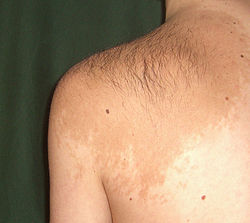Becker's nevus
Editor-In-Chief: Prab R Tumpati, MD
Obesity, Sleep & Internal medicine
Founder, WikiMD Wellnesspedia &
W8MD medical weight loss NYC and sleep center NYC
| Becker's nevus | |
|---|---|

| |
| Synonyms | Becker nevus, Becker's melanosis |
| Pronounce | |
| Specialty | Dermatology |
| Symptoms | Hyperpigmentation, hypertrichosis |
| Complications | N/A |
| Onset | Adolescence |
| Duration | Lifelong |
| Types | N/A |
| Causes | Unknown |
| Risks | Male gender |
| Diagnosis | Clinical diagnosis |
| Differential diagnosis | Congenital melanocytic nevus, Café au lait spot, Nevus spilus |
| Prevention | N/A |
| Treatment | Usually not required |
| Medication | N/A |
| Prognosis | N/A |
| Frequency | 0.5% of the population |
| Deaths | N/A |
Alternate names
Becker melanosis; Becker nevus; Becker naevus
Definition
- Becker's nevus is a non-cancerous, large, brown birthmark occurring mostly in males.
- In very rare cases, Becker's nevus is associated with other skin features; muscular or skeletal features; or underdevelopment (hypoplasia) of the breast. When this occurs, the condition is known as Becker's nevus syndrome.
Cause
- Becker's nevus is due to overgrowth of the epidermis (upper layer of the skin), pigment cells (melanocytes) and hair follicles.
- The specific underlying cause is unknown.
- Because it often forms around puberty in males and is sometimes associated with acne and hair growth, its development may be triggered by androgens (male sex hormones such as testosterone).
Onset
It can be present at birth, but is usually first noticed around puberty.
Signs and symptoms
- A Becker's nevus typically begins to develop around puberty on the shoulder or upper trunk, although it may develop on other areas of the body.
- It is sometimes present from birth.
- Pigmentation (darkening of skin color) may be subtle at first, but the nevus often darkens after puberty and expands.
- The resulting birthmark is usually large, brown, and on one side of the body.
- The nevus may grow more hair than the surrounding skin.
- In some cases, acne develops within the nevus.
Diagnosis
The diagnosis of Becker's nevus is based on clinical features, a biopsy may be necessary to rule out other related conditions.
Treatment
- Becker's nevus typically does not require treatment except for cosmetic reasons - primarily excessive hair growth (hypertrichosis) and hyperpigmentation.
- Treatment has always been challenging, often using lasers with mixed results.
- Q-switched ruby laser has been used with variable success in the treatment of both the hypertrichosis and hyperpigmentation.
- Hypertrichosis may also be improved by laser-assisted hair removal or by electrolysis.
- Hyperpigmentation may be lessened with Q-switched Nd:YAG laser or fractional resurfacing, although responses are variable and recurrence rates are high.
- Acne that develops within the nevus can be treated with standard acne therapies.
- People with Becker's nevi should be examined for associated soft tissue and bony abnormalities.
| Skin cancer of nevi and melanomas | ||||||
|---|---|---|---|---|---|---|
|
NIH genetic and rare disease info
Becker's nevus is a rare disease.
| Rare and genetic diseases | ||||||
|---|---|---|---|---|---|---|
|
Rare diseases - Becker's nevus
|
Transform your life with W8MD's budget GLP-1 injections from $125.
W8MD offers a medical weight loss program to lose weight in Philadelphia. Our physician-supervised medical weight loss provides:
- Most insurances accepted or discounted self-pay rates. We will obtain insurance prior authorizations if needed.
- Generic GLP1 weight loss injections from $125 for the starting dose.
- Also offer prescription weight loss medications including Phentermine, Qsymia, Diethylpropion, Contrave etc.
NYC weight loss doctor appointments
Start your NYC weight loss journey today at our NYC medical weight loss and Philadelphia medical weight loss clinics.
- Call 718-946-5500 to lose weight in NYC or for medical weight loss in Philadelphia 215-676-2334.
- Tags:NYC medical weight loss, Philadelphia lose weight Zepbound NYC, Budget GLP1 weight loss injections, Wegovy Philadelphia, Wegovy NYC, Philadelphia medical weight loss, Brookly weight loss and Wegovy NYC
|
WikiMD's Wellness Encyclopedia |
| Let Food Be Thy Medicine Medicine Thy Food - Hippocrates |
Medical Disclaimer: WikiMD is not a substitute for professional medical advice. The information on WikiMD is provided as an information resource only, may be incorrect, outdated or misleading, and is not to be used or relied on for any diagnostic or treatment purposes. Please consult your health care provider before making any healthcare decisions or for guidance about a specific medical condition. WikiMD expressly disclaims responsibility, and shall have no liability, for any damages, loss, injury, or liability whatsoever suffered as a result of your reliance on the information contained in this site. By visiting this site you agree to the foregoing terms and conditions, which may from time to time be changed or supplemented by WikiMD. If you do not agree to the foregoing terms and conditions, you should not enter or use this site. See full disclaimer.
Credits:Most images are courtesy of Wikimedia commons, and templates, categories Wikipedia, licensed under CC BY SA or similar.
Contributors: Deepika vegiraju, Prab R. Tumpati, MD



